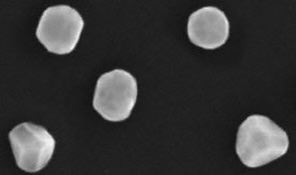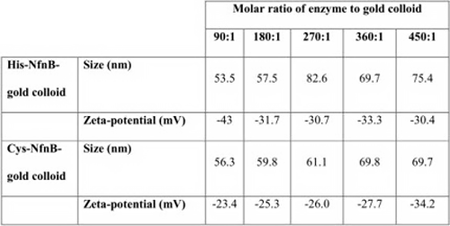

Nanoparticle gold (also known as colloidal gold) is a suspension of sub-micron gold particles typically dispersed in water. The suspension color changes from red to other colors including brown, yellow, and purple as the particle size changes. If the size range is below 100 nm, then the sample can also be called nanoparticles or nanogold. Gold nanoparticles are of great interest for researchers in many fields due to their unique physical and optical properties. These properties change with the particle size distribution, so size analysis is an important measurement requirement. Most particle size analysis tests performed on nanogold is done by microscopy or dynamic light scattering (DLS).

Different sizes of colloidal gold
Recently, the National Institute of Standards and Technology (NIST) has developed Reference Materials (RMs) of gold nanoparticles that are nominally 10, 30, and 60 nm. The RMs were created primarily for evaluating and qualifying instrument performance and/or methodology related to the physical/dimensional characterization of nanoscale particles often used in pre-clinical biomedical research. The RMs could also be useful for developing and evaluating in vitro assays and inter-laboratory test comparisons. These samples were analyzed using the SZ-100V2 Nanoparticle Analyzer.

TEM image of colloidal gold
Gold nanoparticles are researched extensively for use as a vehicle for drug and gene delivery. The gold nanoparticle surface is coated with various payloads such as small drug molecules, proteins, DNA, etc.
Follow this link to download the (free) review article “Gold nanoparticles in delivery applications”.
• Gold Nanoparticles in Delivery Applications
Partha Ghosh, Gang Han, Mrinmoy De, Chae Kyu Kim, Vincent M. Rotello
Advanced Drug Delivery Reviews 60 (2008) 1307–1315
The SZ-100 is an excellent system for determining the particle size and zeta potential of gold nanoparticles as the surface is modified for specific applications. Follow the link below to download an article using the SZ-100 to study gold nanoparticles for drug delivery.
• Colloidal Gold Modified with a Genetically Engineered Nitroreductase: Toward a Novel Enzyme Delivery System for Cancer Prodrug Therapy
Vanessa V. Gwenin, Chris D. Gwenin, and Maher Kalaji
Langmuir, 2011, 27 (23), pp 14300–14307

This table shows the particle size and zeta potential values for colloidal gold base particles (average size 51 nm prior to modification) after immobilizing a prodrug activating enzyme onto the surface at different concentrations.
Nanoparticle Analyzer
Do you have any questions or requests? Use this form to contact our specialists.